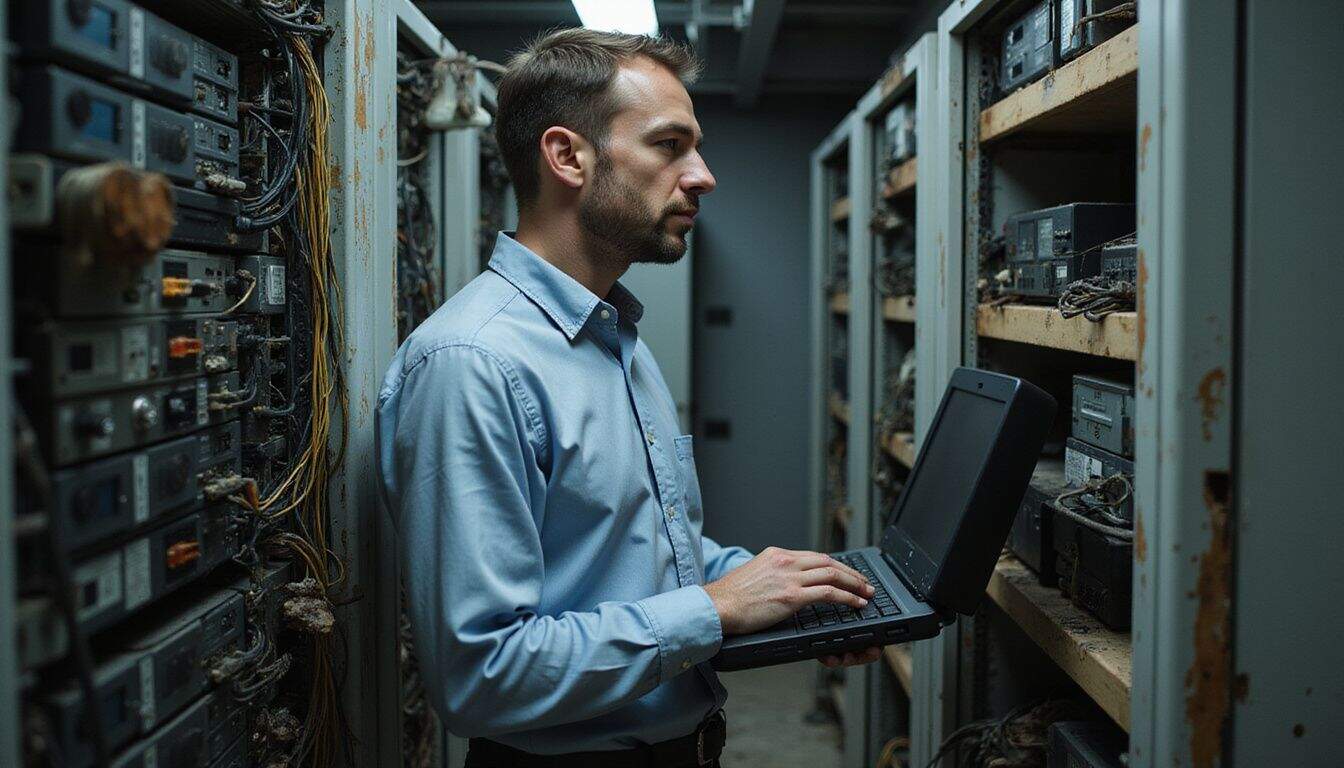You’ve noticed strange noises in your server room, or maybe you’ve spotted tiny droppings near your equipment cables. Pests in your server room can cause system crashes, electrical shorts, and expensive repairs that cost thousands of dollars.
This guide shows you the four biggest pest threats to your data center and gives you proven prevention tips to protect your critical systems. Your servers depend on it.
Key Takeaways
Ants, cockroaches, rodents, and spiders cause server crashes, electrical shorts, and thousands of dollars in equipment damage.
Seal entry points with caulk, install weatherstripping, and add door sweeps to prevent pest infiltration into server rooms.
Daily cleaning, immediate trash removal, and monthly air filter maintenance eliminate food sources that attract server room pests.
Control moisture with dehumidifiers, fix leaks immediately, and maintain HVAC systems to reduce pest attraction to server environments.
Electronic monitoring systems and integrated pest management will replace reactive spraying with proactive 24/7 pest detection by 2025.
Table of Contents
Common Pests Found in Server Rooms
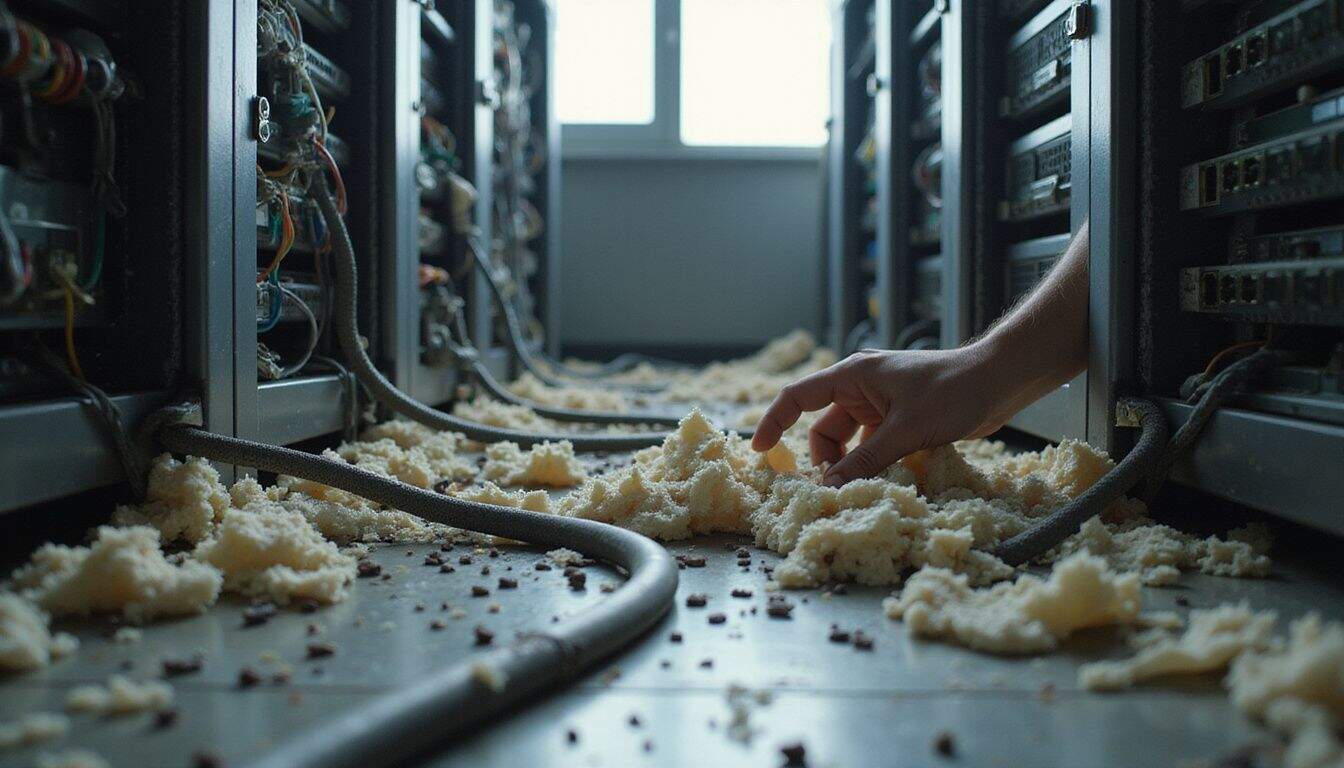
Server rooms attract various unwanted visitors that can wreak havoc on your expensive equipment and critical infrastructure. These tiny invaders slip through the smallest gaps, drawn by warmth, darkness, and the steady hum of your cooling systems — making your data center their perfect home.
Protecting your facility requires a comprehensive approach that addresses entry points, environmental factors, and ongoing monitoring. For businesses in the Greenville area dealing with these persistent intruders, specialized rodent control in Greenville, SC, can provide targeted solutions that keep your critical systems running smoothly.
What problems do ants cause in server rooms?
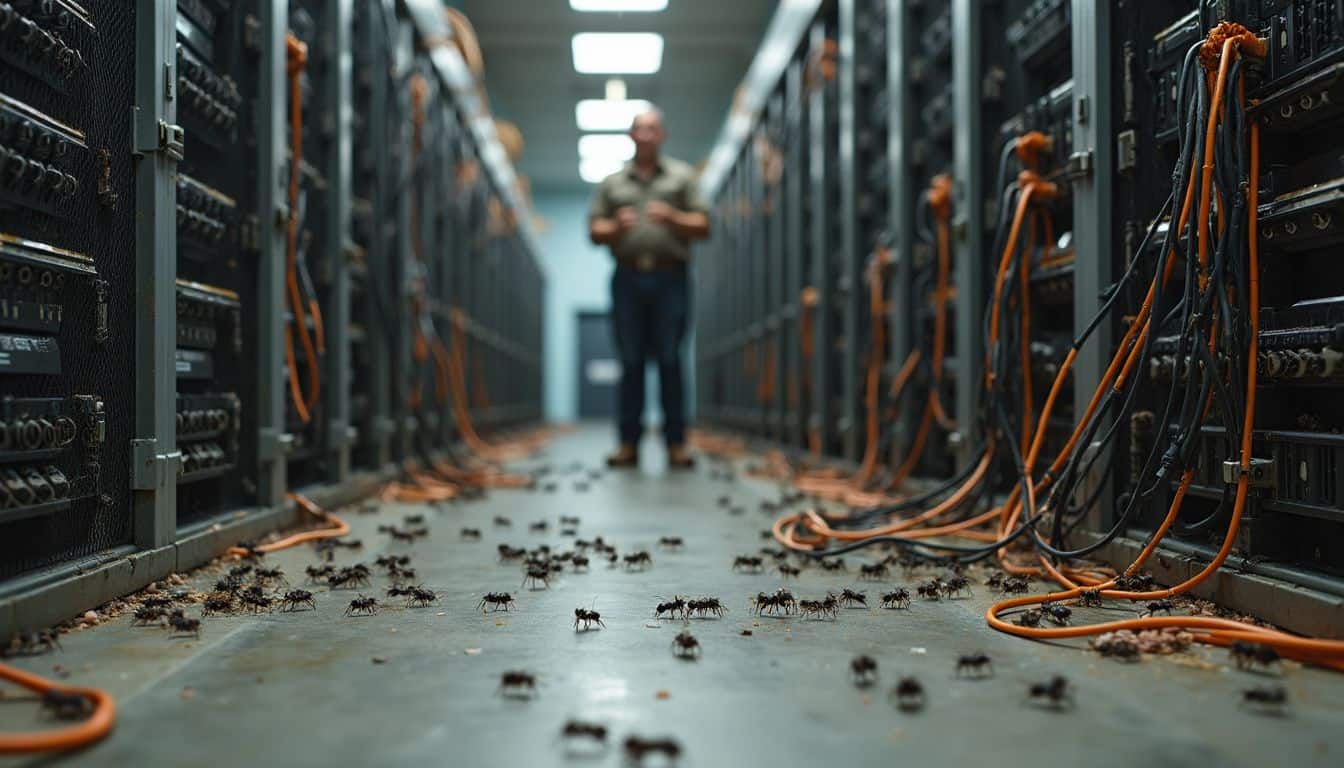
Ants create serious problems in data centers because they’re drawn to the warmth and electromagnetic fields that server equipment generates. These tiny invaders turn server rooms into prime nesting locations, where they chew through insulation and electrical wiring.
Their destructive behavior leads to short circuits, fires, or complete system failure. I’ve seen firsthand how ant colonies can establish themselves inside computer parts and electrical outlets, creating direct fire risks that no IT manager wants to face.
Ignoring ant infestations can result in costly outages and significant financial losses for businesses.
Pest control becomes critical when you consider how ant waste and body fragments contaminate air conditioning systems and affect hardware efficiency. These infestations damage cable insulation, causing equipment malfunctions that breach SLAs and result in lost clients who need uninterrupted service.
The reputational damage to service providers can be devastating, making integrated pest management essential for any serious data center operation. Cockroaches might get more attention, but ants pose equally serious threats to your server infrastructure.
How do cockroaches affect server equipment?
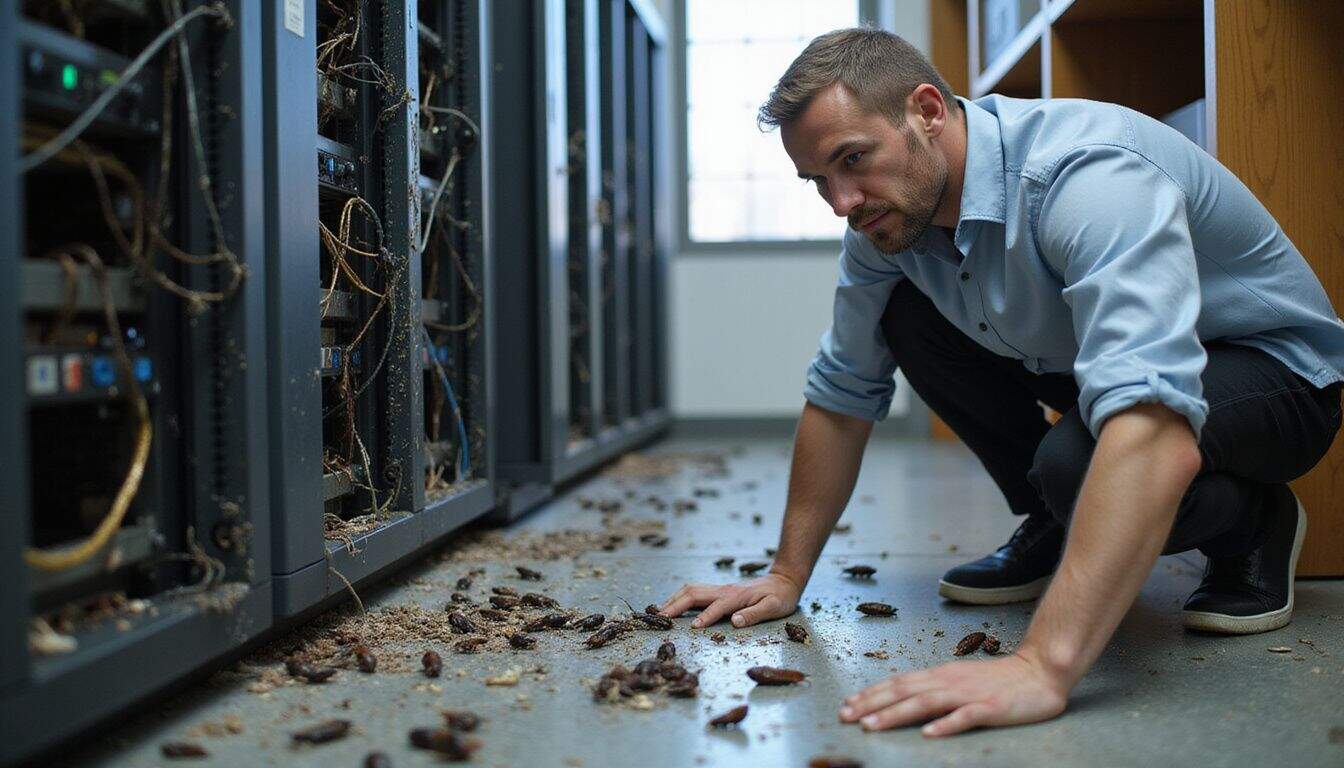
Cockroaches create serious problems for server equipment through multiple destructive pathways. These pests cause short circuits by crawling across electrical components, often triggering fires or complete system failure.
Their waste and body fragments contaminate hardware, leading to significant equipment inefficiencies that can cripple your entire operation. I’ve seen data centers where cockroach infestations resulted in thousands of dollars in damaged servers, with some facilities experiencing total downtime during peak business hours.
Server farms attract cockroaches because of their warmth, electromagnetic activity, and available food sources scattered throughout the facility. These resilient bugs survive in minimal food environments and thrive in almost any condition, making them particularly dangerous for critical infrastructure.
Large infestations increase maintenance costs dramatically while creating unsanitary conditions that violate health and safety regulations. The presence of cockroaches threatens cybersecurity standards required in professional data centers, as their pathogens compromise the sterile environment necessary for optimal server performance.
What risks do rodents pose in server environments?
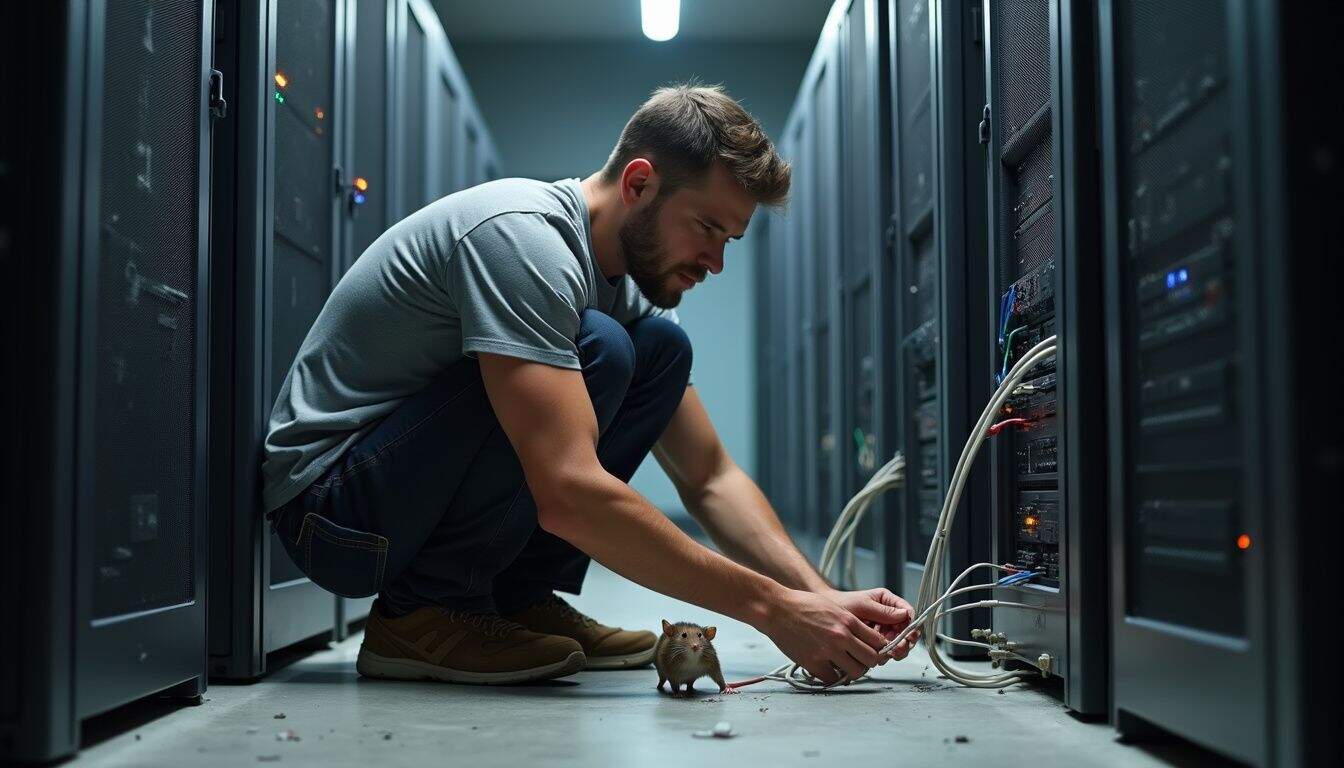
While cockroaches create messy situations with their waste, rodents bring far more destructive capabilities to your server room. These furry invaders are notorious for chewing through wires and insulation, leading to short circuits and fire hazards that can destroy your entire setup.
Their gnawing habits cause total system failures, disrupting crucial data center operations and leaving you scrambling for server infrastructure considerations you never planned for.
Signs of rodent infestation include feces on wiring or vent ducts, visible cable damage, malfunctioning devices, unexpected power loss, and scratching noises behind walls or ceilings.
Mice and rats often seek shelter in warm areas like behind server racks and inside cable trays, contaminating the environment and degrading air quality. These pests enter through service ducts, utility lines, and cracks, violating health and safety regulations in sensitive facilities.
Ignoring rodent problems results in significant financial losses and reputational damage, making integrated pest management essential for any serious data center operation.
Why are spiders a concern in server rooms?
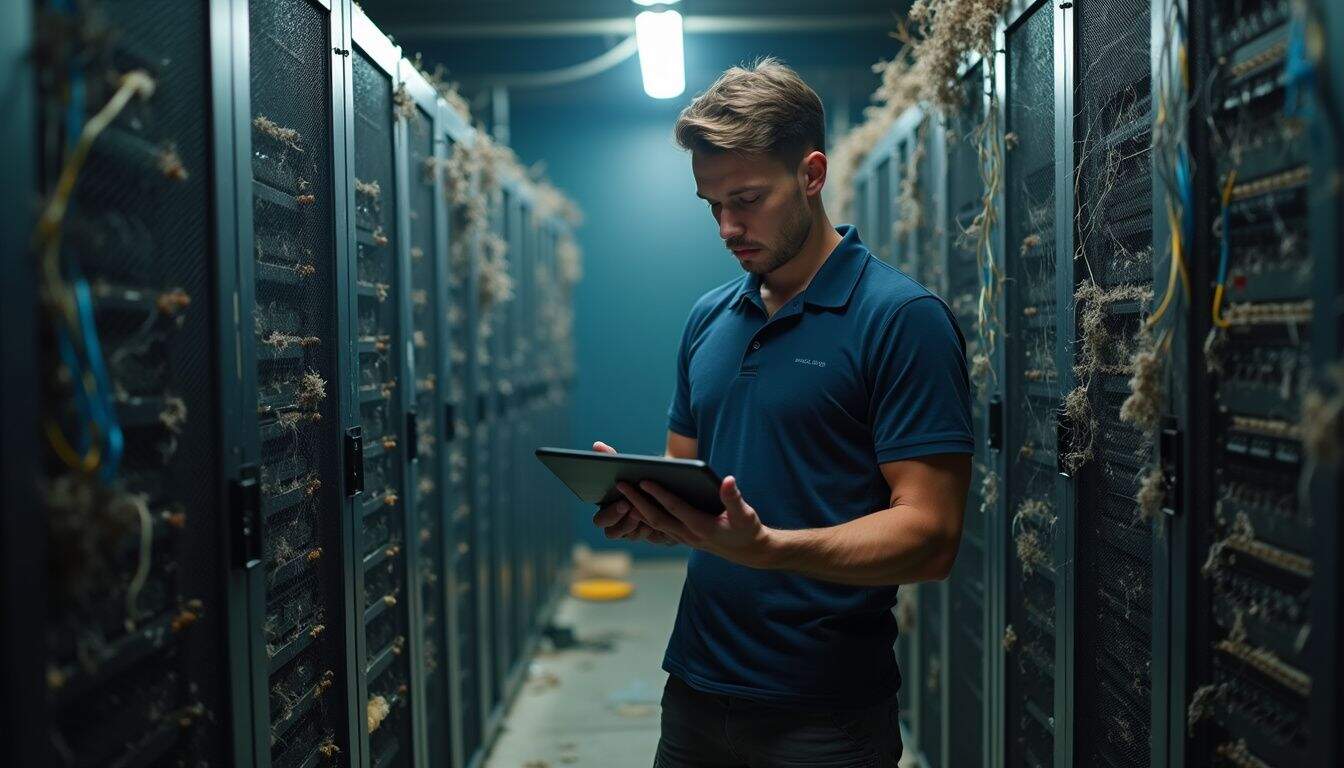
Spiders breed rapidly in server rooms, especially in sub-floor areas where conditions create perfect hiding spots. These eight-legged invaders create cobwebs that clog machines and block airflow in critical equipment.
Their webs and egg sacs worsen infestations over time, making cleanup more difficult without professional help. Spider presence causes employee distress, particularly among staff with arachnophobia who must work in these spaces daily.
Large spider populations signal underlying moisture or insect problems in your data center. Spiders indirectly attract other pests that feed on them or their webs, creating a cascade effect.
Professional pest control assessments become necessary to identify and fix spider issues properly. Webs and egg sacs increase maintenance burdens since they resist standard cleaning methods and require specialized removal techniques.
Spider infestations in server rooms aren’t just about the creepy crawlers themselves, they’re warning signs of bigger environmental problems that need immediate attention.
Now let’s examine the specific preventative measures you can take to keep these unwanted guests out of your server environment.
Preventative Measures for Pest Control

Smart pest control strategies protect your valuable server equipment from unwanted invaders that can cause expensive downtime and damage.
How can I seal entry points to keep pests out?
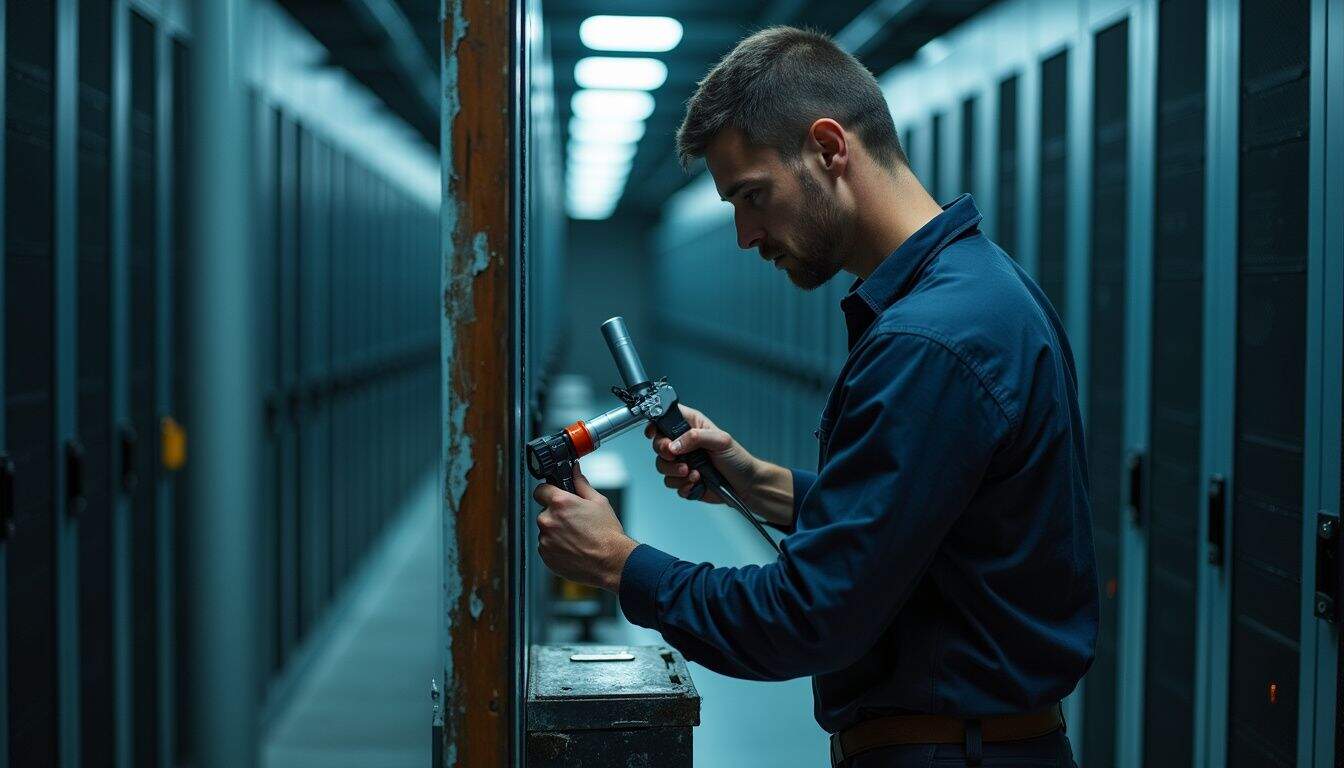
Pests love finding tiny gaps to sneak into your server room, where they can wreak havoc on expensive equipment. Smart sealing strategies keep these unwanted visitors out and protect your critical infrastructure.
- Inspect common areas like doors, windows, pipes, vents, and wall gaps for possible pest entry points during your monthly server room maintenance checks, paying special attention to areas where cables enter the room.
- Use high-quality caulk to fill any gaps or cracks around exterior entry points that you discover during inspections, as even small openings can allow ants and other pests inside.
- Install weatherstripping around doors and windows to create a tight seal against pests while maintaining proper airflow for your HVAC system and server cooling needs.
- Seal interior entry points such as those around pipes, vents, and electrical outlets to block access routes that pests commonly use to reach your valuable server equipment.
- Add door sweeps and mesh screens as additional barriers at entrances to prevent crawling insects from entering while still allowing authorized personnel easy access.
- Conduct regular inspections to identify new or reopened entry points, especially after severe weather events that might damage existing seals or create new gaps in your building envelope.
- Apply industrial-strength sealants around pipe, cable, and vent openings to prevent persistent entry by determined pests who might chew through weaker materials.
- Consider hiring professional pest control services for comprehensive entry sealing if you face ongoing pest issues that threaten your server uptime and backup power systems.
What cleaning practices help prevent pests?
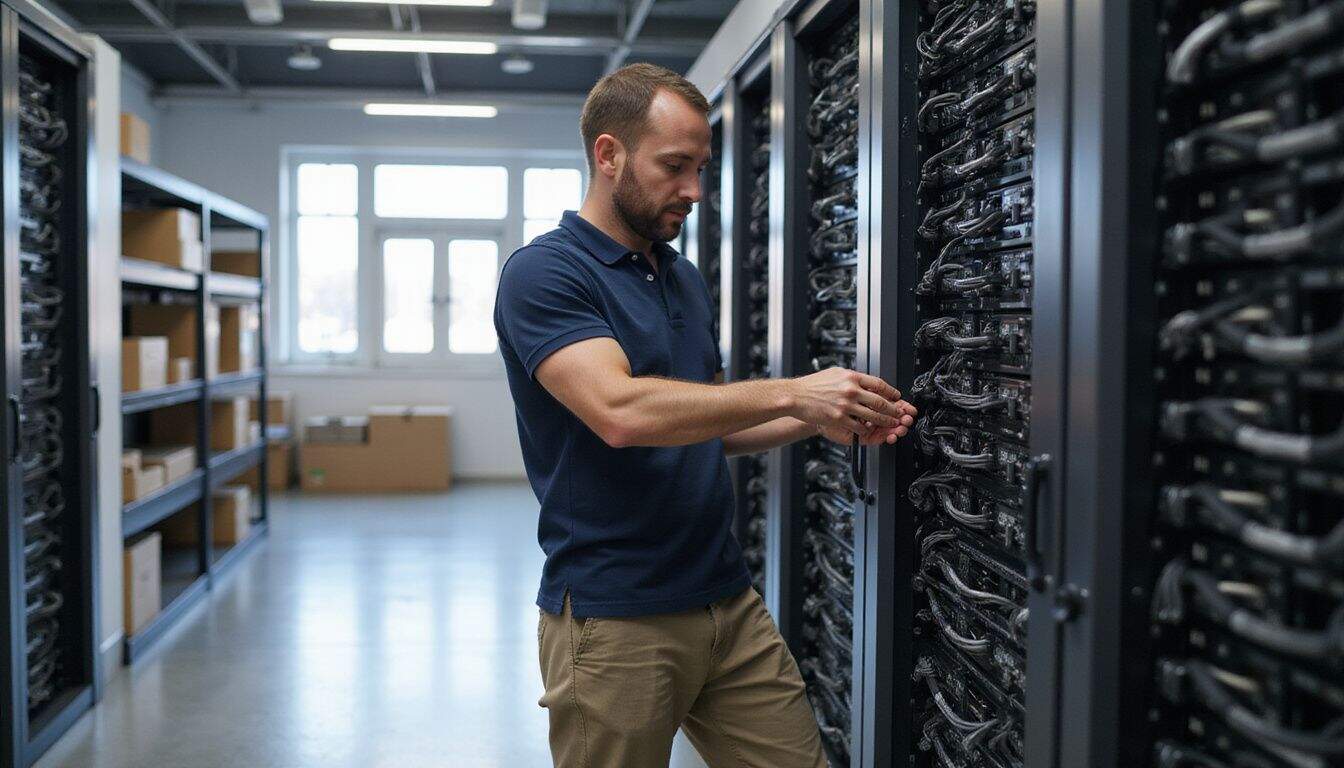
Sealing entry points creates your first line of defense, but cleaning practices form the foundation that keeps pests away long-term. Effective sanitation removes insects and residual food while eliminating potential shelters that attract unwanted visitors.
- Sweep and vacuum server room floors daily to remove food particles and debris that attract ants and cockroaches. Regular cleaning practices such as sweeping, vacuuming, and pressure cleaning help mitigate insect infestations effectively.
- Empty trash bins with tightly sealed lids every 24 hours to prevent pest attraction. Dispose of garbage regularly using tightly closed lids to prevent attracting pests to your critical infrastructure.
- Wipe down all surfaces weekly with approved cleaning solutions that won’t damage sensitive equipment. Professional cleaning services are recommended for server rooms due to invisible contaminants and proper training requirements.
- Remove clutter from floors and storage areas immediately since pests hide in boxes and unused equipment. Reduce clutter or areas where pests can hide, especially on and around the server room floor.
- Clean air vents and filters monthly to eliminate dust buildup that provides nesting material for spiders and other insects. Structural modifications in storage facilities may enhance sanitation and pest prevention efforts.
- Mop floors with disinfectant solutions twice weekly to eliminate scent trails that guide ants to food sources. Check out our comprehensive server room cleaning guide for detailed protocols.
- Sanitize cable management areas quarterly where crumbs and debris accumulate in hard-to-reach spaces. Investments in sanitation practices can significantly reduce long-term pest management costs for your cloud infrastructure.
- Schedule deep cleaning sessions every six months with specialized equipment that reaches behind server racks. Professional teams understand integrated pest management principles and use appropriate chemical pesticides when necessary.
How do I fix moisture issues to reduce pest attraction?

Cleaning alone won’t solve your pest problems if moisture keeps drawing them back. Controlling water sources cuts off what pests need most to survive and breed in your server room.
- Install ventilation fans and dehumidifiers to reduce indoor humidity levels that attract cockroaches and silverfish to your equipment areas.
- Wipe up spills and standing water immediately to eliminate moisture sources that draw ants and other pests seeking hydration.
- Tighten or replace dripping faucets to prevent constant dampness that creates perfect breeding conditions for various insects.
- Fix leaking pipes in crawlspaces to avoid damp soil conditions that attract cockroaches, silverfish, and other moisture-loving pests.
- Empty containers or trays under houseplants and refrigerators regularly to prevent water accumulation that serves as pest drinking stations.
- Maintain HVAC systems and replace filters to prevent excess humidity buildup that makes your server room attractive to insects.
- Control relative humidity with properly calibrated environmental systems to keep moisture levels below pest-friendly thresholds.
- Monitor equipment areas for leaks or condensation, addressing water issues immediately to limit pest attraction before infestations develop.
- Check for condensation around cooling units and pipes, as these water sources often go unnoticed but attract pests consistently.
How Will Server Room Pest Control Evolve in 2025?

Server room pest control will see major changes in 2025. Electronic monitoring systems will run 24/7 to catch problems early. These smart devices will track pest activity around the clock, sending alerts before infestations spread.
Integrated pest management (IPM) models will become the standard approach. Companies like Rentokil are already testing these advanced systems in data centers. Green solutions will replace harsh chemicals, focusing on heat treatments and non-toxic methods that won’t damage sensitive equipment.
Partnerships between tech companies and specialized pest management firms will grow stronger. These experts understand server environments better than general extermination services.
Real-time monitoring will help teams spot issues with termites, bedbugs, and other threats instantly. Light trap technology will improve to catch flying insects without creating electromagnetic interference.
The shift means less reactive spraying and more proactive upkeep. Data analysis will drive decisions about where to place monitoring devices and which treatments work best for each facility.
People Also Ask
What makes server rooms vulnerable to pest problems?
Server rooms create perfect conditions for unwanted visitors. The warm environment, steady power supply, and quiet spaces attract various creatures looking for shelter and food sources.
Which pests pose the biggest threats to server equipment?
Rodents top the list because they chew through cables and wiring. Insects like ants and cockroaches can cause short circuits, while birds and bats may nest in ventilation systems and damage cooling equipment.
How does integrated pest management work in data centers?
Integrated pest management combines multiple strategies to keep facilities pest-free. This approach includes sealing entry points, removing food sources, and using targeted treatments only when necessary.
What pest control methods work best for server environments?
Professional pest control services offer the safest solutions for sensitive equipment areas. They use low-toxicity treatments, install monitoring stations, and create customized prevention plans that protect both your hardware and staff.
References
https://www.pestclinic.com.sg/why-pests-in-data-centres-are-a-hidden-threat-what-to-do/ (2025-06-17)
https://www.spraguepest.com/de-bugging-data-server-farms/ (2023-12-13)
https://protectpestcontrol.sg/pages/pest-control-for-data-centres
https://pestdoc.com/6-ways-to-effectively-seal-entry-points/
https://ladybugsallpestsolutions.com/preventing-pest-entry-seal-common-entry-points/
https://pmc.ncbi.nlm.nih.gov/articles/PMC10816060/
https://www.grainger.com/know-how/operations/facility/kh-pest-control-prevention-methods (2023-04-21)
https://www.extermpro.com/blog/how-moisture-contributes-to-pest-problems/
